Walnuts and Roses
Over a century in the making, Julia and Dave Malcolm’s lovely home and garden at Swannanoa just 35 km north of Christchurch has developed a relaxed and quintessentially Canterbury vibe. Peaceful and productive, the property quietly reflects the hard work and attention to detail the couple have put into their private landscape since they moved here 24 years ago. Words & Photos Martin Wilkie.
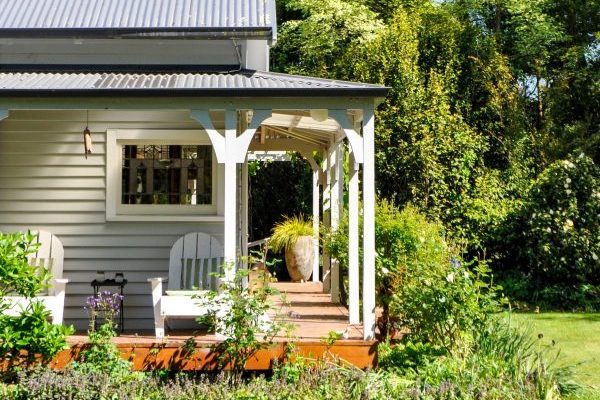
On the route inland to Oxford, the Swannanoa district has been farmed since at least the mid-19th century, when John Evans Brown from North Carolina settled here in 1864 on land owned by his brother-in-law. He named the run-holding for the Swannanoa River, and when he and his family later returned to North Carolina, with a nice sense of symmetry he named their next home Zealandia. A rail line between Kaiapoi and Oxford which once passed through the district was completed in 1878 (it closed in the early 1960s) and the original railway station site, now a private home, is at the intersection just a few hundred metres from Julia and Dave Malcolm’s front gate.
Julia and Dave have 4.2 hectares of land; their present bungalow-style homestead was built around 1919, near the site of an earlier house with gables which is now part of the woodland garden, planted with silver birches and purple rhododendrons. In 2000 when they arrived, the outlines of the original garden were still visible: roses (including red ‘Frensham’), Buxus hedging, a grass tennis court, an old ‘Conference’ pear tree and white-fleshed nectarine, a large sycamore, tall elms around the implement sheds, and a row of 10 enormous macrocarpa trees. These macrocarpa provided fine-grained timber for building projects during the first three years, including a new kitchen floor and two more verandas around the house. Weeds and scrub came right up to one of the house walls, and had to be cleared with a digger before the new veranda could be built.
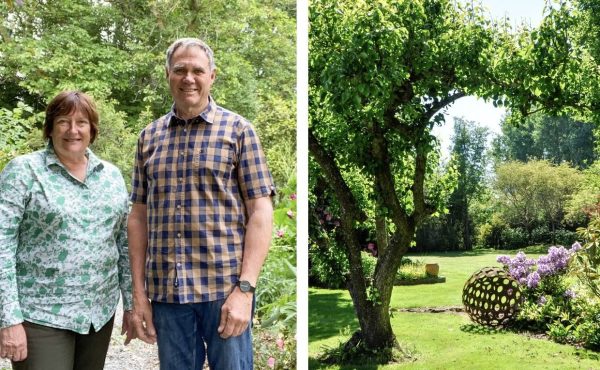
The couple were both full-time teachers, and much of the heavy work was carried out during term holidays. Straight after Teachers College, Dave had completed further training in horticulture (later teaching science, biology and horticulture) which proved very useful in setting up the new property, and again after 2018 when he became a full-time gardener. About 75 per cent of the land was bare paddocks with light free-draining fertile soil: technically an Eyre stony silt loam, ‘although we don’t have too many stones’.
Keen to use the space more productively, the couple researched different tree crops such as olives, hazelnuts and walnuts. They decided that walnuts were likely to suit the local conditions best (Swannanoa is too cold to properly ripen olives) and as mature trees their ongoing maintenance would be manageable, so between 2001 and 2003 an intensive planting programme began.
Silver birches (seed-grown from trees at Lincoln University) formed a light woodland canopy for shade and shelter.
Shelterbelts went in first: Leyland cypress, ‘Crow’s Nest’ poplar, and areas of native planting around the garden’s perimeter. Rust-resistant poplar cuttings were also sourced locally for free: offcuts were collected and trimmed from a neighbour’s shelterbelt, and left bundled in the nearby water race over winter; by spring over 1,000 rooted cuttings were ready for planting! Two hundred and sixty young walnut trees (mostly ‘Rex’ and ‘Meyric’, unique New Zealand varieties) were set out at nine-metre-square grid spacing, and irrigated from an on-site well, now powered by solar panels.
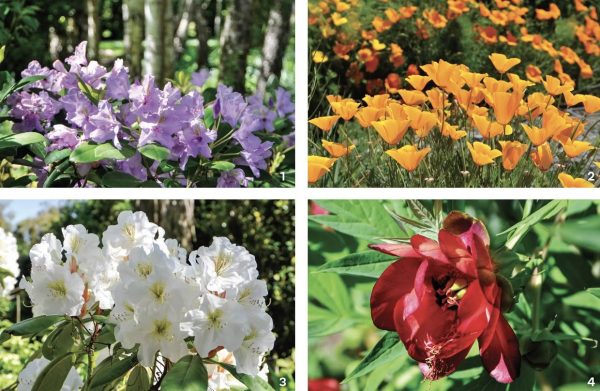
With the shelterbelts becoming established and the garden now ‘cleared for action’, Julia and Dave could get on with enriching the soil and planning the ornamental planting – gradually setting out the different layers of trees, shrubs, hedges and herbaceous perennials. The garden expanded organically, using plants from their previous garden, seedlings and cuttings propagated in their own tunnel house, and gifts from friends and family. Silver birches (seed-grown from trees at Lincoln University) Judas tree Cercis, Paulownia, variegated English elms, ornamental cherries and crab apples, maples (including the spectacular Acer griseum with its cinnamon-coloured peeling bark and vivid autumn colour) and many other trees formed a light woodland canopy for shade and shelter. Other spaces in full sun were developed as lawns and richly planted garden beds.
After nearly 25 years of growth, first impressions are of a garden entirely at ease in its own skin, filled with so many flowering plants familiar to Cantabrians it’s like greeting a crowd of old friends. ‘It’s not a posh garden’, says Julia, ‘… we are proud of it, and our friends like it.’ The open lawns are ideal spaces for larger family gatherings, and magnets for active children.
Gardeners get to know which plants do well in their area – Dave and Julia together have a good eye for placement and a wealth of practical experience, and enjoy a network of knowledgeable gardening friends and family from both town and country. For example Julia and I discovered that we had had mutual friends at the Canterbury Flower Arrangement Society, and special plants generously gifted as slips, cuttings, seeds and divisions by those characterful women were growing in both our gardens.
By mid-November there are still plenty of late rhododendrons in flower and roses are starting to hit their stride, along with delphiniums, herbaceous peonies and other perennials. Lavender-purple rhododendrons are repeated around the garden, including the bullet-proof R. ‘Fastuosum Flore Pleno’ under the avenue of silver birches. This classic hybrid, bred before 1846, is a cross between arguably the two hardiest wild species from North America and Europe respectively: R. catawbiense x R. ponticum. Another rhododendron ‘County of York’ combines crisp white flower trusses with shiny apple-green foliage. Scented deciduous azaleas (botanically members of the Rhododendron genus) are thriving in light woodland shade next to pathways – coral-pink ‘Ilam Paradise’ is a standout. Out in the sun, those familiar roses are settled amongst intense blue delphiniums, plump pink peonies and pale blue bearded Iris: shell-pink ‘Leander’ and ‘Cécile Brunner’; and richly scented apricot ‘Abraham Darby’; plus ‘Penelope’, ‘Jacqueline du Pré’, ‘Sally Holmes’, ‘Margaret Merril’ and ‘Many Happy Returns’ – all shades of blush white. Shrub/climbers include ‘Mutabilis’, apricot-yellow ‘Crépuscule’ (meaning ‘twilight’), ‘Cocktail’ with single raspberry-red flowers and a primrose eye, salmon-pink ‘Compassion’ and blood-red ‘Dublin Bay’; and pale pink ‘Paul’s Himalayan Musk Rambler’ clambering over an old tree trunk.
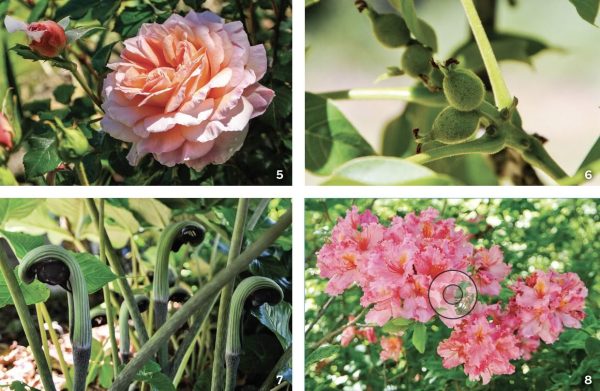
Many of the old-fashioned flowering shrubs valuable for seasonal picking have a home here too (Julia is a talented flower arranger): Weigela, Hydrangea, Chaenomeles ornamental quince, and a self-seeded grove of the Himalayan tree daphne D. bholua.
Herbaceous perennials at ground level are similarly a mix of hardy survivors and unexpected rarities: hellebores, Rodgersia, hostas, peonies, Tradescantia, dahlias and Symphytum, plus a significant collection of trilliums and one of Dave’s particular interests, Arisaema. A thriving clump of A. ringens Cobra Lily shows off its predatory-looking green blooms under handsome trifoliate leaves, and the pale flower spathes of A. consanguineum appear to follow the sun. Himalayan lilies Cardiocrinum giganteum have naturalised around the garden – about 20 of their tall flowering stems appear each summer. Ironically the original plants came from Abel Tasman National Park: Dave saw a group of seedlings just over a fence growing on the DOC estate, and successfully transplanted the bulbs to Swannanoa with a clear conscience!
Productive, sheltering and sustaining, this beautiful family garden with all its memories rests gently on the soil thanks to Dave and Julia’s practical good sense and generosity.
Julia and Dave have enjoyed hosting international travellers via the ‘HelpX’ scheme for over 20 years, whereby singles and couples from as far away as Spain, France and the Czech Republic volunteer to work four or five hours a day in return for free accommodation and food. After approximately 109 visitors to date they’ve ‘never had a dud’, and extra hands during busy times are always appreciated: for house painting, firewood preparation, walnut harvesting, native tree planting; and recently a new pigsty. Many of these volunteers have kept in touch, and Julia and Dave have met up again with several of them during their own overseas travels.
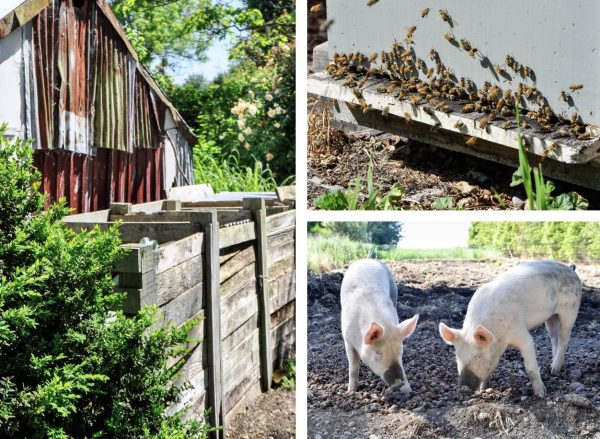
There are sculptures around the garden (particularly a swimmer in the pond, and a wandering metal sphere) plus products of Dave’s own building and joinery skills. These include the main driveway gates, and a second Cape Cod style chair on the veranda, to make a pair. He also brings clean green waste home from his work to top up the nine big compost bins behind the vegetable garden, which easily absorb the garden’s clippings, prunings and autumn leaf drop.
The placement of these bins is a nice example of how the practical elements of the house and garden are just where you’d hope to find them. There’s a generous covered space right outside the back door to the kitchen for gumboots, wet-weather gear, spare fridge and washbasin; vegetables and herbs are just across the concrete path; pipfruit trees (‘Liberty’ apple and ‘Beurré Bosc’ pear) and fruiting currants are next to the vege garden, and the compost bins are just around the corner from the fruit trees; all very handy. There are also beehives close by, producing around 30 kg of honey annually from two collections: one before Christmas and the other in late January; fruit set around the property noticeably improved after the bees arrived.
Two pigs typically appear in July and take their leave approximately six months later after what Julia describes kindly as ‘a short but meaningful life!’ Their nutritious diet includes plenty of walnut ‘seconds’ (nuts too small or with marked shells) from the 2.5 tonnes harvested annually. Most of the crop is processed in Blenheim, some goes to a granola company in Christchurch, and the rest is sold or traded locally.
Productive, sheltering and sustaining, this beautiful family garden with all its memories rests gently on the soil thanks to Dave and Julia’s practical good sense and generosity; a fine example of effectively balancing the different aspects of give and take in our approach to the land.

